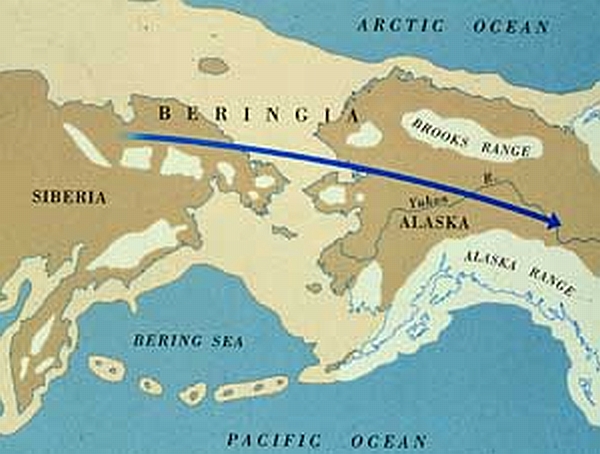
By NICHOLAS WADEMARCH 12, 2014
Using a new method for exploring ancient relationships among languages, linguists have found evidence further illuminating the peopling of North America about 14,000 years ago. Their findings follow a recent proposal that the ancestors of Native Americans were marooned for some 15,000 years on a now sunken plain before they reached North America.
This idea, known as the Beringian standstill hypothesis, has been developed by geneticists and archaeologists over the last seven years. It holds that the ancestors of Native Americans did not trek directly across the land bridge that joined Siberia to Alaska until the end of the last ice age, 10,000 years ago. Rather, geneticists say, these ancestors must have lived in isolation for some 15,000 years to accumulate the amount of DNA mutations now seen specifically in Native Americans.
Archaeologists examining deep sea cores from the Bering Strait believe that a special ecological zone known as shrub tundra existed there during the Last Glacial Maximum, an exceptionally cold period that lasted from about 30,000 to 15,000 years ago. Though often referred to as a bridge, the now sunken region, known as Beringia, was in fact a broad plain. It was also relatively warm, and supported trees such as spruce and birch, as well as grazing animals.
Writing in the journal Science last month, John F. Hoffecker, an archaeologist at the University of Colorado, summarized the evidence for thinking the Beringian plain was the refuge for the ancestral Native American population identified by the geneticists. “The shrub tundra zone in central Beringia represents the most plausible home for the isolated standstill population,” he and colleagues wrote.
Dr. Hoffecker believes that the ancestral Native Americans could have kept warm with fires of animal bones and wood, and that their range was restricted by the availability of wood. “The paleoecological data is consistent with the idea of a refugium, and the wood might be a key variable,” he said in an interview.
Linguists have until now been unable to contribute to this synthesis of genetic and archaeological data. The first migrations to North America occurred between 15,000 and 10,000 years ago, but most linguists have long believed that language trees cannot be reconstructed back further than 8,500 years. Vocabulary changes so fast that the signal of relationship between two languages is soon swamped by the noise of borrowed words and fortuitous resemblances.
But in 2008, Edward Vajda, a linguist at Western Washington University, said he had documented a relationship between Yeniseian, a group of mostly extinct languages spoken along the Yenisei River in central Siberia, and Na-Dene.
The Na-Dene languages are spoken in Alaska and western Canada, with two outliers in the American Southwest, Navajo and Apache. His assertion that the two families of languages had descended from a common tongue implied that he was seeing back in time at least 12,000 years or so, to the arrival of Na-Dene speakers in North America.
Many linguists accepted Dr. Vajda’s analysis, despite its time depth. He relied heavily on structural features of language, which turn out to be more resistant to change than vocabulary. In particular, he looked at Yeniseian and Na-Dene verbs, since languages in both groups have a template of fixed positions before and after the verb for specifying various attributes.
Building on Dr. Vajda’s success, two linguists, Mark A. Sicoli of Georgetown University and Gary Holton of the University of Alaska, have assessed the relationship of the two language families based on shared grammatical features, rather than vocabulary.
In a paper published in the journal PLoS One on Wednesday, they report their surprising finding that Na-Dene is not a descendant of Yeniseian, as would be expected if the Yeniseian speakers in Siberia were the source population of the Na-Dene migration. Rather, they say, both language families are descendants of some lost mother tongue. Their explanation is that this lost language was spoken in Beringia, and that its speakers migrated both east and west. The eastward group reached North America and became the Na-Dene speakers, while the westward group returned to Siberia and settled along the Yenisei River.
The Na-Dene migration from Beringia came after the main migration of 15,000 years ago, but the relationship between the two populations remains to be settled. “There may have been multiple streams of people moving out of that single source at different times,” said Dennis H. O’Rourke, an anthropological geneticist at the University of Utah.
If Yeniseian represents a return migration from Beringia, the question of the source population in Siberia of Native Americans is thrust back into obscurity. “If Yeniseian is off the table as a back-migration, there is no other candidate,” Dr. Sicoli said.
Several Yeniseian languages are known only from czarist fur tax records. Pumpokol, Arin, Assan and Kott have not been spoken for two centuries. The only surviving language, Ket, has fewer than 200 living speakers.
